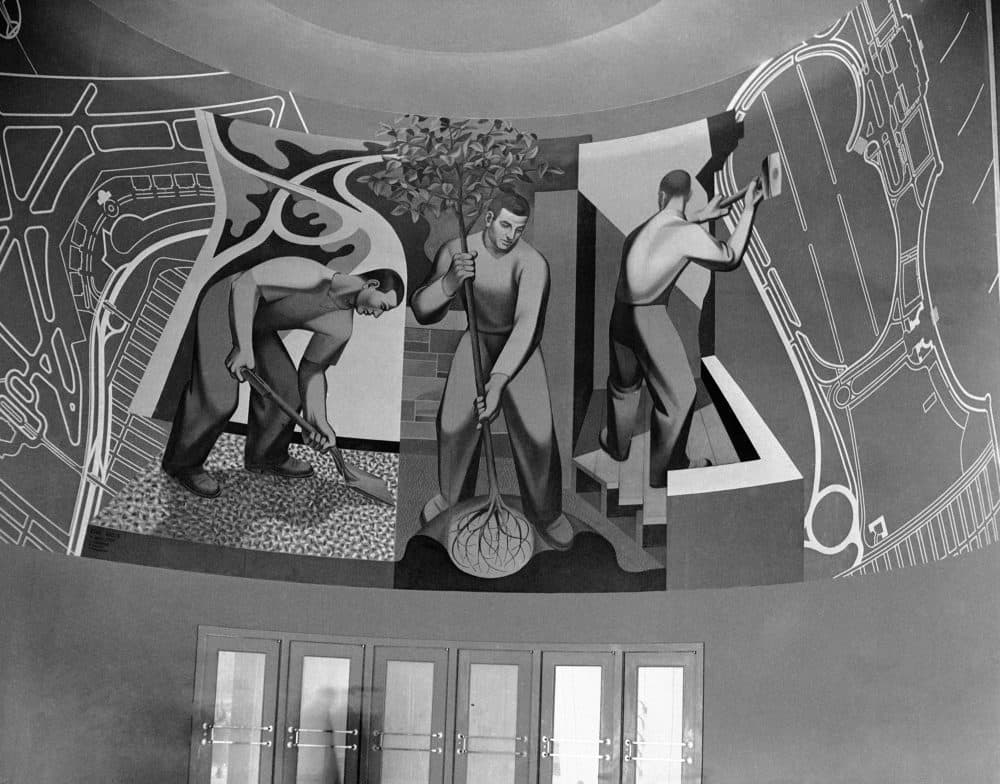Advertisement
What The Depression-Era Works Progress Administration Can Teach Us About The Arts During A Crisis

In the 1930s, former President Franklin D. Roosevelt enacted job creation programs that put thousands of artists to work.
The best-known program was the Works Progress Administration, which led to the development of community arts centers in minority communities across the country. The WPA was inspired in part by post-revolutionary thinking in Mexico, says Ohio State University art history professor Jody Patterson.
Before FDR came into office, a cultural movement was gaining visibility in Mexico. After the military stages of the Mexican Revolution, the country’s government hired artists as wage laborers to visualize history and make it accessible to the hundreds of thousands of citizens who were illiterate, she says.
“This kind of collective expression was very much the model that was taken on by the Federal Art Project and transposed into the American context,” says Patterson, who authored the book “Modernism for the Masses: Painters, Politics and Public Murals in 1930s New York.”
Through WPA, several hundred thousand works were created by professional artists. Many Americans experienced original artwork for the first time through WPA concerts or public art such as murals, some of which still stand today.
Community art centers held traveling exhibitions and art classes, she says, which made art part of people’s everyday lives. Mural painting is one successful way the program fulfilled its intention of giving Americans access to the arts, she says.
At New York City's Schomburg Center for Research in Black Culture, art history lovers can still see a set of murals by Aaron Douglas, a black artist from the Harlem Renaissance who later became an instructor within the federal art programs. Douglas’ murals depict the history of life and culture for black Americans.
“That mural cycle … is there as this kind of visual history, much like we would have had stained glass windows or frescoes in churches during earlier periods,” she says. “Here is a history that — regardless of your level of education or literacy, your familiarity with fine art — is there in bold color and form. “
Advertisement
President Roosevelt also used art programs as a way to communicate the value of democracy in the U.S. Across the world, leaders such as Adolf Hitler, Joseph Stalin and Benito Mussolini were also funding art to consolidate their power, Patterson says.
Roosevelt needed to build support for government action and show how democracy offered citizens a “more abundant life” full of culture compared to the competing political systems of the time, she says.
Because of the coronavirus pandemic’s effect on the economy, many people are thinking back to Depression-era programs like WPA. But there are significant differences between the economic crisis in the 1930s compared to now, she says.
Now, Congress can’t agree on anything and President Trump has not shown support for the arts, she says. Trump has called for the elimination of the National Endowment for the Humanities and the National Education Association. Plus, his supporters don’t think culture is within the purview of the federal government, she says.
“Even though there has recently been an emergency aid bill, Roosevelt's program was pushed through by a popular president whose party controlled both houses of Congress,” she says. “And it came at a time when I think a lot more people in government were able to see maybe the morale-boosting benefits of creating more space for culture as part of an everyday experience.”
One similarity between this era and now is that many Americans find federal funding for the arts wasteful and “boondoggling,” a term used to describe Roosevelt’s initiatives, Patterson says.
“Many people, as is still the case today, did not think it was the business certainly of the federal government to be getting involved in cultural matters,” she says.
For decades, the cultural sector in the U.S. has been in a precarious, vulnerable position compared to other industries, she says. In the aftermath of this crisis, she thinks people may realize it’s not sustainable that funding for art largely comes from wealthy elites or private philanthropy.
Though circumstances have changed since the New Deal, there are useful insights and lessons to learn from these programs, she says. She hopes the art world can build on the legacy of programs like WPA and make culture more accessible — akin to living the American dream instead of “something that's cast off into this ivory tower and left so vulnerable.”
“This could be an opportunity to think about what a sustainable future for the arts might look like,” she says.
Lynn Menegon produced this interview and edited it for broadcast with Tinku Ray. Allison Hagan adapted it for the web.
This segment aired on April 29, 2020.

